Abstract
Classical theories of harmony have been used to explain phenomena like beauty, happiness, health, virtue, pleasure, peace, and even ecological sustainability. With the intent of making these theories more accessible to designers, this article reviews the conception of harmony from about 500 BCE to the present. It begins with a brief overview of harmony in classical Chinese and Greek philosophy. Then it examines the role of harmony in the renaissance, the scientific revolution, and the early modern period across topics in aesthetics, ethics, physics, politics, and economics. Finally, turning to the 20th century, this article highlights the conceptual function of harmony in psychology, neuroscience, computer science, and design. This synthesis concludes with a review of applications and implications for contemporary designers. An essential conclusion of this article is that harmony involves the integration of diversity into a greater whole; harmony is not pure agreement or “sameness.” Overall, we suggest that classical principles of harmony might serve as a theoretical framework to help designers develop a more sustainable and vibrant vision of the future.

Lomas, J. D., & Xue, H. (2022). Harmony in design: A synthesis of literature from classical philosophy, the sciences, economics, and design. She Ji: The Journal of Design, Economics, and Innovation, 8(1), 5-64.



